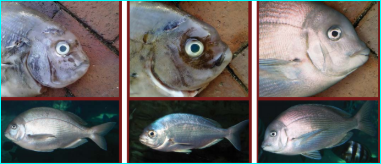
Very often, fish are incorrectly identified due to their similar appearance. In some cases, there are small but very specific differences that enable one to distinguish between similar looking species.
Some species, such as the Rockcod family are near impossible to identify correctly as the colours of live and dead specimens vary. Colour is the biggest differentiator, so it’s important to take note of the colouring of any species you are trying to identify. Photographs are ideal for later identification, but remember there is a big difference between an average photo and a great photo.
In the next few issues of USM, we will discuss several species that are extremely similar and difficult to identify, as well as some of those that are easily recognizable.
Up first are 3 fish commonly misidentified by most divers: the Bronze Bream, Blue Hottentot and German Bream.
The above photograph clearly shows the three fish and although they are very easily confused, once placed adjacent to each other, the differences are quite obvious.
Bronze Bream
Pachymetopon grande SA Record 5.4kg (D. Calitz, 1987) This is perhaps one of the fish most commonly encountered by spearos. Big Bronzies (+3kg) are cunning and only good bottom times and extreme patience will yield success. Although the literature states that they are shallow water fish, they have been found at depths exceeding 30m by spearos able to hunt this deep. Bronze Bream have fewer teeth than the Blue Hottentot and German Bream, which is the easiest manner of identification.
Blue Hottentot
Pachymetopon aeneum SA Record 3.14kg (R. Neethling, 1992) This fish closely resembles the Bronze Bream, except the head and body is more “blue”, however this colouring fades soon after death. The body is also more elongated than the Bronze and German Breams which have somewhat deeper bodies. The bulge above the eyes is also not as pronounced as with the Bronze Bream. Blue Hotties are normally found in deeper water beyond the range of most divers.
German Bream
Polyamblyodon germanum SA Record 3.2kg (S. Atlas, 1974) The German Bream is most often confused with the Bronze Bream as it is also relatively common. However, it is not usually encountered on shore dives. The most distinguishing feature that differentiates the German Bream from the Bronze Bream, is the protruding mouth and teeth. The German Bream also has molars which the Bronze Bream and Blue Hottentot lack.
